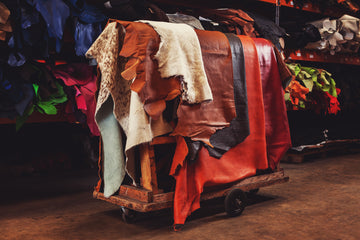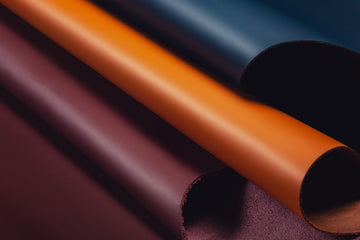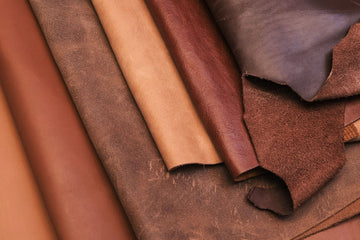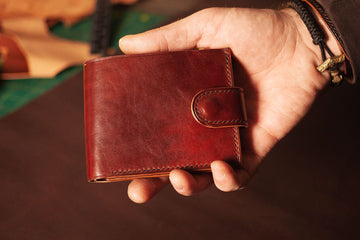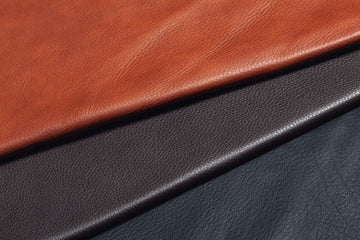Leather for belt making: How to choose the best?
The world of leather belts can be daunting, but in this guide, we'll help you find the best material and thickness for your belt that is not only fashionable but also durable and long-lasting.
With wide varieties of leathers on offer, such as different cuts, it's essential to consider all factors before investing in a stylish yet reliable piece, ultimately expressing personal style backed up by quality craftsmanship.
What is the most durable leather for belts?
When it comes to belts crafted from leather, the best quality is vegetable-tanned full-grain material sourced from a double butt cut of skin from an animal. This thick skin provides thickness relative to stretch and resistance against stretching. Perfect for creating straps that endure over time. With a higher price tag than other types of leather products, pairing this top-notch quality with solid brass hardware will guarantee you have long-lasting accessories that are worth every penny spent!
What thickness of leather is best for belts?
The right leather thickness for a belt is essential to ensure perfect quality, support and comfort. The ideal range is 8.5-9.5 ounces (1/8 - 9/64 inches). This provides adequate durability while still being pleasant around your waistline. A slight variance in this area can make all the difference in the world regarding the long-term enjoyment of wearing your beloved belt!
What is the highest quality leather for belts?
In belt making, full grain leather is unrivalled for its surface, which gives excellent strength and durability. It is softer and has a natural look that will acquire an aged patina over time – this makes the full grain leather the highest quality of all types of leather available in belts.
Apart from full grain leather, other kinds like top grain leather, genuine leather or bonded leather varieties are frequently used when creating such items. All provide good quality, but none match those crafted using superior-grade materials like full-grain hide, either texture-wise or resilience-wise.
What makes a high-quality leather belt?
High quality belts are crafted from a number of factors, most notably the type of leather cut and consistent thickness. The double butt, shoulder, and belly cut all play an integral part in affecting its final outcome.
To make solid leather belts enhance their durability and strength, it is also essential to consider the belt's thickness. Vegetable tanned leather will give you that unique finish or texture too. Lastly, there should be minimal waste produced during production for excellent results!
Is genuine leather suitable for leather belts?
When choosing a leather belt, investing in one made of solid leather constructed with higher-quality materials is better for greater durability. Leather belts manufactured from genuine and bonded leather are less reliable due to their low grade composition consisting of scrap material, providing limited use before replacing the item after around 6 months. For a long-term accessory, choose full grain vegetable tanned leather that guarantees high quality results and increased resilience against wear over time.
Understanding leather types for belts
The universe of leather leather for belts is varied, with various sorts of leather giving extraordinary attributes and benefits. This part will investigate the diverse kinds of leather used for making belts. - Full grain leather, top grain leather, genuine leather and even bonded leather. We will likewise examine their appropriateness for creating belts.
Full grain leather stands apart as the most excellent quality available – it's made from the upper layer or 'cover' hide, which has been unaltered in any capacity other than being cleaned to evacuate soil particles naturally present on animal skin fur/hide surface layers. It gives fantastic toughness just as advantageous characteristics like breathability that are liked by many fashioners who make premium quality men's & women's luxury designer Italian belts.
Top full grain leather covering "split cowhide" is a moderate choice. Still, despite everything, it offers enormous strength while having an indistinguishable adaptable feel when producing goods, including traditional buckle style genuine black brown classic fashionable modern handmade cowboy western Dress Patrol webbing.
Is full grain leather good for belts?
Belts made from full grain leather are known for being incredibly long-lasting and stylish. Since it's the strongest, most durable section of hide, these belts retain their natural texture and grain, which means they won't fade over time like other types of leather might. Although costlier than its counterparts, investing in a belt crafted with full grain leather will give you excellent quality and an attractive patina that develops as you wear it more often.
Is top grain leather good for belts?
Top grain leather, including full and corrected varieties, is a great quality belt material. It has the advantage of durability and presenting a smooth finish thanks to its sanding/buffing process in making corrected grain leather.
It offers an excellent cost-benefit compared with other options without compromising too much on quality.
Compared to full grain hide, the top layer can be more easily coloured and put through various finishing processes, which makes it a desirable choice amongst many buyers who seek something unique but also practical at lower prices than other materials like full grain hide would allow them. This type of animal skin remains a popular option due to its balance between strength, affordability, and look!
Is genuine leather good for belts?
When purchasing a belt, genuine leather for belts should be avoided due to its low quality and lack of durability. Genuine leather for belts is made from scraps of the lowest grade material and will only last for a short time compared to other options like full or top grain leather belts with better wear resistance.
Full grain leather or top-grain is highly recommended to invest in a good quality item that can withstand regular use without showing signs of tear quickly. Leather qualities such as these are ideal when looking for an aesthetically pleasing piece that won't need replacing any time soon!
Is bonded leather good for belts?
When it comes to belt making, bonded leather is not a recommended option since its durability level is low. This type of bonded leather – created using scrap grain leather and polyurethane – can easily become cracked or split, resulting in the accessory lasting for only a short period of time.
For belts built to last, investing in either full grain or top grain quality should be considered, as these two types offer greater resilience when compared with bonded varieties. Using genuine leather ensures better outcomes if you're looking for an enduring item made from this material, such as belt straps and buckles.
What is the most durable leather for belt?
When crafting a top-notch belt, selecting the proper leather cut is critical. In this section, we'll investigate which cuts are ideal for making belts such as double butt, shoulder and belly. Each of these offers certain advantages and disadvantages when used in combination with one another. Double butt is usually the most commonly employed cut for creating belts, while both shoulder and belly present alternatives depending on individual preferences regarding quality or other factors relating to design or comfortability.
Double butt cut
The leather cut of cowhide that is best for belts is the double butt cut, as it has the characteristics of excellent thickness and consistency with minimal waste. This variety of hide comes from the cow and hind leg section, which yields a regular squared shape and enhanced thickness to withstand fibre deterioration over time, making these kinds of belts both durable and long-lasting.
Shoulder cut
Belts made from the split shoulder cut are an option, but only if the animals chosen have a square shape and provide enough thickness and length. Though practical, this isn't quite ideal when compared to double butt cuts due to its thinner size and squared form.
Belly cut
When it comes to making belts out of genuine cowhide and leather, the full cowhide belly cut could be a better option due to its peculiar shape and greater flexibility, even though this type of cut works well for other articles such as wallets, handbags and totes. Its features make it unsuitable for crafting genuine belts.
The thin, irregular form renders it difficult to create an even width or length on the belt itself, which means that attaining consistency in size can be tricky with this particular cutting technique.
Is vegetable tanned leather suitable for belts?
Belts made from vegetable-tanned leather are highly respected in belt making, as this tanning method uses natural tannins derived from plants. The following paragraphs detail how to recognise genuine vegetable-tanned leather for belts and its advantages compared to other methods of tanning leather for belts.
Vegetable tanning is a process which extracts naturally occurring tannins found within vegetation for use on belts or any other article crafted out of animal hide. Due to these properties, it stands out among the various processes used today, such as chrome vs. plant-based, etc.,
Besides being one hundred per cent organic, it also offers flexibility during craftsmanship while providing durability afterwards. All valuable qualities that cannot be achieved by artificial means alone.
Process of vegetable tanning
Vegetable tanning is a natural and sustainable way of treating leather that yields an eco-friendly product. By soaking the material in tannin extracts from plants such as oak, chestnut or mimosa together with other chemicals, vegetable tanning makes it more sturdy and water-repellent. Compared to traditional methods, this approach results in a durable item whilst also helping conserve our environment.
Advantages over other tanning methods
Vegetable tanned leather is seen as a more natural leather choice for those seeking the longevity and patina development this type of hide tanning offers. It also delivers on sustainability due to being made from renewable plant-based materials used in tanning processes.
This durable option will withstand wear & tear better than other types of leather and can avoid fading or cracking with time - making it an ideal material for all kinds of products like clothing, footwear, etc.
How to identify vegetable tanned leather?
To be sure a piece of leather is vegetable-tanned, two simple tests can be done. By applying light pressure with an awl and looking for a visible line that appears when scratched, it becomes evident whether the material has undergone this type of tanning process.
Submerging a small strip in boiling water should cause the grain of leather to split and curl up quickly if tanned using vegetables. This kind of split out of leather hide typically comes with half its natural colour, firmness, and aroma distinct from other processes.
What thickness of leather is best for belts?
When selecting the proper thickness for your leather belt, comfort and longevity are essential. Knowing what factors influence this choice — like the type of buckle or intended use — and common measurements are essential. The leather used in a belt's construction also affects its optimal thickness selection. To guarantee those desired qualities, we must ensure that our chosen measurement effectively meets all these criteria.
Do thin or thick leather belts look better?
When selecting a leather belt, it is helpful to know the average thickness. A wide range of measurements can be found from 8.5-9.5 ounces, which translates into 1/8-9/64 inches or 0.4mm in equivalent terms per ounce.
With this knowledge, you can confidently pick out your desired leather belt!
Factors affecting thickness selection
When selecting the thickness of a leather belt, several factors must be considered. Firstly, think about what the intended use is. Personal preference also plays a vital role in this decision-making process. Pay attention to details such as the type and weight of the leather being used and its width: these all influence how sturdy or flexible your belt will be.
Quality matters too – look out for animal kind & breed plus size & finishing on that particular piece's surface before you commit! Ultimately, each one of those points can significantly affect how thick your new accessory should end up being aesthetically speaking but functionally, too.
What thickness of leather is best for belts?
When selecting the right thickness of a leather belt, it is important to consider its use, as well as one's individual style and how durable the material will be. Be sure that when wearing it, you find comfort in its size, neither too bulky nor too thin. Taking all of these factors into consideration while picking out your ideal belt thickness can guarantee optimal satisfaction with every wear!
Creating custom leather strips for belts
Making personalised leather belts can be rewarding if you work with your hands instead. To begin the process, you need various items, such as a cutting knife for leather, a ruler, and a board to cut on.
Once these supplies are in order, we will go over how to create and precisely craft the leather belt strips from raw materials and what additional touches should be added before it's finished. Crafting beautiful and durable custom belts out of durable quality leather has never been so easy!
What are the best tools and materials for belt making?
The right tools are necessary to make high-quality leather strips for belts. With a strap cutter or sharp knife and a straight edge, you can precisely cut out shapes in your chosen piece of leather that will become your belt. To give it an individual look and feel, stamps or punctures need to be added with hammering and punching equipment like awls, burnishers or hole punches. Skiving knives help create thinner pieces ideal for edging around straps.
Finally, sewing tools and lacing devices enable effective assembly together with careful finishing touches aided by sponges & softwood sticks to bring everything together into a single product - creating the desired custom-made belt from scratch!
Leather belt cutting techniques
To create custom leather strips, one can utilise either a strap cutter or draw along the length of it with a straight edge and sharp knife. First, measure the size you expect to need for your strip on half the surface before marking it down as a reference. Afterwards, take your blade along half this line to achieve an even-cut strip of leather tailored to its needed length. Leatherwork may be made much simpler when using these techniques!
Finishing touches
The final touches of crafting a leather belt require burnishing the edges, adding holes for buckles, and giving it some kind of protective finish, such as wax or sealant. Shaping your leather into smooth curves by bevelling its sides will add to the aesthetics while also helping with longevity. Punch out these openings using a specialised tool like a rotary cutout or use a typical hole puncher.
These steps are essential in creating an excellent outcome when making custom leather straps that can stretch and last longer than expected!
Caring for your leather belt
Proper maintenance is crucial for a leather belt to remain attractive and last. This part focuses on cleaning and conditioning it, storing it correctly, and avoiding damage or wear. Regular cleaning with a soft cloth will do wonders to keep the leather in good shape. Conditioning also plays an essential role. This ensures your piece looks presentable for longer periods by nourishing it without over-saturating it so that no discolouration happens! In terms of storage, make sure you choose a cool place away from direct sunlight exposure - though if needed, hang up instead of folding your belt since too many folds can weaken any belt.
Cleaning and conditioning your leather belt
Regular maintenance is essential to keep leather belts in excellent condition and extend their life. Start by using a mild cleaner like saddle soap to remove any dirt or revive the material of the belt. Then, use a soft cloth with some leather conditioning cream and massage gently over every part of the surface for flexibility.
Storing your leather belt
It's essential to take proper care of your belt. Hanging or rolling it up is an effective way to prevent wrinkles and other forms of damage from occurring. Keep the accessory out of any moist and warm spaces, as this can negatively affect its condition over time. Protecting it by avoiding direct sunlight is also necessary so that dust does not accumulate on the material surface, thus ensuring longevity for many years.
Preventing damage and wear
To protect your belt from wear and tear, keep it away from water, heat, and the sun's rays. Handle with care by not forcefully pulling or yanking on it so that its quality stays intact for longer. Cleaning procedures along with correct storage instructions are key elements in guaranteeing the longevity of this piece of accessory while maintaining its style at all times.
What type of leather is best for a belt?
As a leather craft maker, you want a quality leather belt that lasts for years. Make sure it is made from full grain vegetable tanned leather. Pay attention to the cut and thickness of the material when choosing your piece. When choosing your leather, the cut is an essential factor to consider. The double butt cut, for instance, offers a balance of thickness and flexibility, making it ideal for belts that need to withstand regular use. The shoulder cut, on the other hand, is often used for belts that require a more uniform appearance.
In conclusion, when crafting a leather belt, the choice of material, cut, and thickness can significantly impact the quality and durability of the final product. By choosing full-grain vegetable-tanned leather and paying careful attention to these factors, you can create a great belt that stands the test of time.
🔗 Shop the best leather for belts
Please don't hesitate to contact us if you need a better understanding of the regular use of various leather types and grades for belt making. Then, we can help you choose the right leather, the perfect leather that enhances your leather belt's aesthetics and longevity.
